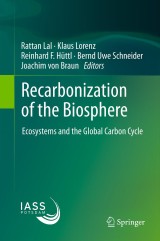Details

Recarbonization of the Biosphere
Ecosystems and the Global Carbon Cycle|
213,99 € |
|
| Verlag: | Springer |
| Format: | |
| Veröffentl.: | 28.03.2012 |
| ISBN/EAN: | 9789400741591 |
| Sprache: | englisch |
| Anzahl Seiten: | 560 |
Dieses eBook enthält ein Wasserzeichen.
Beschreibungen
Human activities are significantly modifying the natural global carbon (C) cycles, and concomitantly influence climate, ecosystems, and state and function of the Earth system. Ever increasing amounts of carbon dioxide (CO2) are added to the atmosphere by fossil fuel combustion but the biosphere is a potential C sink. Thus, a comprehensive understanding of C cycling in the biosphere is crucial for identifying and managing biospheric C sinks. Ecosystems with large C stocks which must be protected and sustainably managed are wetlands, peatlands, tropical rainforests, tropical savannas, grasslands, degraded/desertified lands, agricultural lands, and urban lands. However, land-based sinks require long-term management and a protection strategy because C stocks grow with a progressive improvement in ecosystem health.
<p>Foreword.- Terrestrial Biosphere as a Source and Sink of Atmospheric Carbon Dioxide.- Climate Change Mitigation by Managing the Terrestrial Biosphere.- Atmospheric Chemistry and Climate in the Anthropocene.- Historic Changes in Terrestrial Carbon Storage.- Soil Erosion and Soil Organic Carbon Storage on the Chinese Loess Plateau.- Methane Emissions from China’s Natural Wetlands: Measurements, Temporal Variance and Influencing Factors.- Accounting more precisely for peat and other soil carbon resources.- Permafrost - Physical Aspects, Carbon Cycling, Databases and Uncertainties .- Carbon Sequestration in Temperate Forests.- Decarbonization of the Atmosphere: Role of the Boreal Forest under Changing Climate.- Recarbonization of the Humid Tropics.- Carbon Cycling in the Amazon.- Grassland Soil Carbon Stocks: Status, Opportunities, Vulnerability.- Cropland Soil Carbon Dynamics.- The Carbon Cycle in Drylands.- Carbonization of Urban Areas.- Potential Carbon Emission Trajectories of Shanghai, China from 2007 to 2050.- Processes of Soil Carbon Dynamics and Ecosystem Carbon Cycling in a Changing World.- Terrestrial Carbon Management in Urban Ecosystems and Water.- Carbon Storage and Sequestration in Subsoil Horizons: Knowledge, Gaps and Potentials.- Transforming Carbon Dioxide from a Liability into an Asset.- The Economics of Land and Soil Degradation – Toward an Assessment of the Costs of Inaction.- Assessment of Carbon Sequestration Potential in Coastal Wetlands.- Research and Development Priorities Towards Recarbonization of the Biosphere.</p>
This book describes comprehensively carbon (C) cycle process in global ecosystems and the potential and co-benefits of recarbonization of the biosphere. An ever increasing human population is disposing increasing amounts of carbon dioxide (CO<sub>2</sub>) into the atmosphere by land use and land cover changes but most importantly by burning of fossil fuels. This process severely perturbs the natural global C cycles and Earth system processes. Recarbonization of the biosphere is a potential strategy to redistribute C among global pools, and to enhance ocean but most importantly land-based C sinks. Sustainably managed and protected must be, in particular, the large and sensitive C stocks in permafrost, wetlands, peatlands, tropical rainforests and savannas, grasslands, degraded/desertified lands, and croplands. Recarbonization requires long-term management because C stocks grow with a progressive improvement in ecosystem health. Protecting and enhancing land-based C sinks serves food security aside contributing to climate change mitigation and adaptation.
Nobel laureates and renowned experts deliberate on the possibilities of managing the Earth-Human System for slowing-down atmospheric increases in carbon dioxide and for recarbonization of the biosphere The comparison of ecosystems and their role in the global carbon helps the reader in identifying challenges and opportunities to prioritize C sinks for managing recarbonization Includes interdisciplinary and transdisciplinary approaches for redistribution of C among biospheric C pools
Diese Produkte könnten Sie auch interessieren:

The Vicuña

von: Iain Gordon, Jane C. Wheeler, Hugo Yacobaccio, Jerry Laker, Marcelo Cassini, Mariela Borgnia, Yanina Arzamendia, Verónica Benítez, Bibiana Vilá, Cristian Bonacic, Jessica Gimpel, Pete Goddard, Desmond McNeill, Gabriela Lichtenstein, Renaudeau d' Arc Nadine, Kristi Anne Stølen, Javier García Gomez, Ana Wawrzyk

96,29 €

Saving Biological Diversity

von: Robert A. Askins, Glenn D. Dreyer, Gerald R. Visgilio, Diana M. Whitelaw

96,29 €

Martens and Fishers (Martes) in Human-Altered Environments

von: Daniel J. Harrison, Angela K. Fuller, Gilbert Proulx

149,79 €













